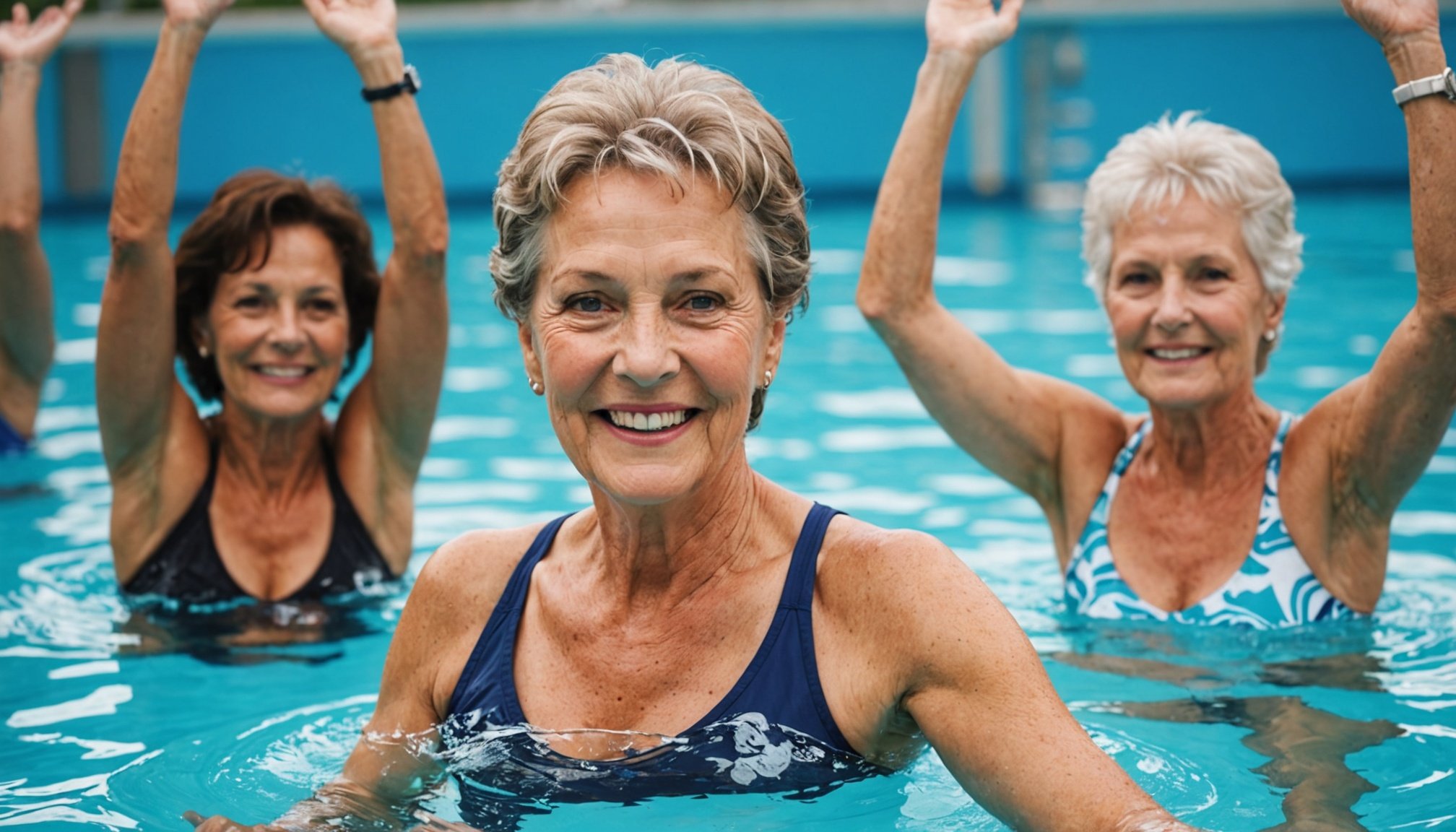Overview of Water Aerobics Benefits for Seniors
Water aerobics benefits extend beyond mere fitness; they offer a holistic approach to seniors’ health improvement. By participating in these exercises, seniors enjoy significant enhancements in cardiovascular and muscular health. Water’s natural resistance aids in building strength while simultaneously improving heart efficiency. Moreover, this gentle form of exercise provides effective endurance training, which is crucial for maintaining an active lifestyle.
One standout feature of water aerobics is its low-impact nature, considerably reducing the risk of injury. The buoyancy of water supports the body, lessening the strain on joints and muscles. This makes it particularly beneficial for seniors, who often contend with conditions like arthritis and osteoporosis.
Fitness, however, is not the sole advantage. The social and psychological benefits of joining group classes cannot be understated. Water aerobics sessions offer opportunities for social interaction, combating loneliness and enhancing emotional well-being. Such communal activities can lead to enduring friendships, providing seniors a sense of belonging and community involvement.
Water aerobics, therefore, is not just about physical well-being. It fosters mental health and seniors’ fitness, emphasizing the multi-faceted benefits of embracing this aquatic practice.
Safety Recommendations for Seniors in Water Aerobics
Engaging in water aerobics is a fantastic way for seniors to boost their health, but safety remains paramount. A critical step before starting any new exercise program involves seeking medical consultation. This ensures that seniors understand any specific health considerations they need to be mindful of, tailored to their individual needs.
Once cleared, assessing pool conditions is crucial for injury prevention. Seniors are encouraged to check the accessibility to the pool area, ensuring it has non-slip surfaces and handrails for support. These attributes enhance safety and make water aerobics more enjoyable. If pool conditions fall short, seniors should seek alternative facilities that prioritize safety.
Using appropriate aids like flotation devices can further safeguard seniors during exercises. These aids maintain buoyancy and provide confidence while performing aquatic routines. It’s important to understand how to use them correctly to maximize their benefit and to avoid potential hazards.
Seniors should also warm up before sessions and start gradually, adapting intensity as their confidence and fitness improve. Listening to their body’s signals and resting when needed are vital components of a safe exercise routine in water aerobics. These steps collectively contribute to a safe and fulfilling water aerobics experience.
Suitable Water Aerobics Exercises for Seniors
Engaging in the right water aerobics routines can greatly benefit seniors, enhancing overall health and fitness. These exercises, tailored to the needs and abilities of older adults, often include a variety of components that address different aspects of physical health.
Gentle Warm-Up Exercises
Initiating with gentle warm-up exercises helps prepare the body. Movements like water walking or easy arm circles are effective in gradually increasing heart rate and ensuring joints are ready for more strenuous activities. These set a positive tone for the session, making subsequent exercises more enjoyable and effective.
Strength-Building Activities
Focusing on strength-building activities within water aerobics is crucial. Utilizing water resistance with exercises such as underwater leg lifts or using equipment like resistance bands adds an effective strength-training component. These exercises help maintain muscle mass and promote bone health, vital for seniors’ fitness.
Flexibility and Balance Drills
Flexibility and balance are core aspects of aquatic fitness. Exercises such as water-based yoga poses or tippy-toe balancing improve these areas. They contribute to better posture and reduce the risk of falls, greatly enhancing seniors’ quality of life.
This well-rounded approach to water aerobics routines not only boosts physical health but also reinforces self-esteem and independence for participants.
Testimonials and Success Stories from Seniors
Hearing senior testimonials reveals the profound impact water aerobics can have on personal health and well-being. Many seniors credit water aerobics with significant health improvements and transformative lifestyle changes. One participant, aged 72, shared that regular sessions helped ease arthritis pain, allowing more enjoyable walks with family and friends. Such stories underline the importance of this form of exercise in enhancing mobility.
Success stories also highlight the rich tapestry of experiences among seniors. From a retired teacher overcoming loneliness through group classes to a former athlete regaining strength, these anecdotes underscore the diverse backgrounds and starting points of participants. These classes often serve as a social outlet, creating meaningful connections and combating feelings of isolation.
Community engagement lies at the heart of water aerobics. Participants frequently mention the supportive environment that fosters companionship and encouragement. As one 65-year-old remarked, engaging in water aerobics not only improved her fitness but also nurtured new friendships within the classes.
Understanding these personal narratives emphasizes the emotional and physical benefits of water aerobics, encouraging more seniors to explore this enriching exercise option. It can significantly improve both individual well-being and quality of life.
Finding Water Aerobics Classes Near You
Venturing into water aerobics begins with locating suitable classes, which can significantly enhance seniors’ fitness journeys. There are several resources available to help you find community fitness programs, focusing on local water aerobics.
-
Community Centers: These are reliable venues often offering aquatic classes tailored to seniors. They provide supportive environments and foster community engagement.
-
Private Fitness Facilities: These organizations also have specialized programs, sometimes with smaller class sizes for individualized attention.
When selecting a class, instructor qualifications are paramount. Qualified instructors ensure safe settings and can adapt exercises to meet diverse needs. Each class should be structured, incorporating warm-ups, main activities, and cooldowns, fostering comprehensive aquatic fitness development.
Beyond traditional locations, online platforms can also help in discovering local pools offering water aerobics. Websites often list facilities with their class schedules and specific fitness programs, easing the search process.
By examining available options, seniors can make informed decisions about joining water aerobics classes, considering which type of facility best matches their preferences and support needs. Whether in community centers or private venues, these classes provide a welcoming space focused on enhancing overall health and wellness.
Expert Advice on Incorporating Water Aerobics into a Routine
Creating a balanced weekly fitness routine that includes water aerobics is essential for maximizing health benefits for seniors. Experts recommend starting with regular sessions, ideally two to three times a week, as part of a comprehensive senior health plan. Consistency is key, gradually building stamina and strength over time.
Setting realistic goals is crucial in maintaining motivation and progress in water aerobics. Goals should be personalised, whether they’re aimed at improving endurance, enhancing senior health, or simply enjoying the aquatic environment. Achieving these milestones not only boosts physical wellness but also significantly enhances psychological satisfaction.
In addition to water aerobics, incorporating other forms of exercise contributes to overall wellness. Activities such as walking, light weight training, or yoga complement aquatic routines by promoting muscle tone, flexibility, and cardiovascular health. These combined efforts create a well-rounded fitness approach that supports comprehensive health improvements.
Expert tips water aerobics focus on listening to one’s body and adapting exercises based on individual comfort levels. If fatigue or discomfort occurs, it’s appropriate to adjust the intensity or duration of workouts. By following these guidelines, seniors can confidently embrace water aerobics, blending enjoyment with substantial health benefits.





